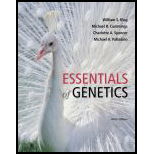
Concept explainers
CASE STUDY| Doggone it!
A dog breeder discovers one of her male puppies has abnormal genitalia. After a visit to the veterinary clinic at a nearby university, the breeder learns that the dog's karyotype lacks a Y chromosome, but instead has an XX chromosome pair, with one of the X chromosomes slightly larger than usual (being mammals, male dogs are normally XY and females are XX). The veterinarian tells her that in other breeds, some females display an XY chromosome pair, with the Y chromosome being slightly shorter than normal. These observations raise several interesting questions:
Can you offer a chromosomal explanation of these two cases?
To review:
Normally, the breeds of dogs have homozygous females (XX) and heterozygous males (XY), but in other dog breeds, females are heterozygous (XY) with Y chromosome a little shorter than its normal size. In the given case, the male puppy is found to have abnormal genitalia and its karyotype showed that it lacks a Y chromosome and possess an XX chromosome pair. Give the chromosomal explanation of the given cases.
Introduction:
From the chromosomal theory of inheritance, it is known that genes that are units of the genetic material, which is DNA (deoxyribonucleic acid), are present on the chromosome (condensed DNA). These chromosomes are passed down to the daughter cells during cell division. When the genetic material in the parent cell is mutated, then the mutated form of the same will be inherited by the progeny.
Explanation of Solution
Dogs have a total of 39 pairs of chromosomes with 38 pairs of autosomes that define the somatic characters and 1 pair of sex chromosomes that are also called allosomes that control the development of reproductive organs. Generally, in mammals, females are a homogametic organisms having 2 X chromosome, out of which one X chromosome is inactivated. The males are heterogametic with one X and one Y chromosome. The Y chromosome carries genes that define the development of male reproductive organs. In females, out of the two X chromosomes, one is almost entirely inactive as one X chromosome is enough to define the characters of a female.
In some dog breeds, the females carry XY chromosomes, with Y chromosome a little shorter than the normal size. In this case, it would be possible that the factor responsible for determining the development of testes is absent in such females as the Y chromosome is of shorter length.
The dog exhibiting male characteristics but having XX karyotype have one slightly larger X chromosome. In this case, the X chromosome that is donated by the father would have combined with the Y chromosome. Thus, X chromosome would be larger than the normal as it has extra genes from the Y chromosome. These genes from Y chromosomes would control male sexual characteristics. Thus, the genitalia would be abnormal.
Thus, it can be concluded that generally, dogs have an XX chromosome pair for females and XY pair for males. In some breeds, the female has X and a shorter Y then that Y chromosome must be lacking the gene that determines the development of testes. Also, in XX males, one X chromosome would have Y chromosome genes that resulted in abnormal genitalia.
Want to see more full solutions like this?
Chapter 5 Solutions
Essentials of Genetics (9th Edition) - Standalone book
- Describe the principle of homeostasis.arrow_forwardExplain how the hormones of the glands listed below travel around the body to target organs and tissues : Pituitary gland Hypothalamus Thyroid Parathyroid Adrenal Pineal Pancreas(islets of langerhans) Gonads (testes and ovaries) Placentaarrow_forwardWhat are the functions of the hormones produced in the glands listed below: Pituitary gland Hypothalamus Thyroid Parathyroid Adrenal Pineal Pancreas(islets of langerhans) Gonads (testes and ovaries) Placentaarrow_forward
- Describe the hormones produced in the glands listed below: Pituitary gland Hypothalamus Thyroid Parathyroid Adrenal Pineal Pancreas(islets of langerhans) Gonads (testes and ovaries) Placentaarrow_forwardPlease help me calculate drug dosage from the following information: Patient weight: 35 pounds, so 15.9 kilograms (got this by dividing 35 pounds by 2.2 kilograms) Drug dose: 0.05mg/kg Drug concentration: 2mg/mLarrow_forwardA 25-year-old woman presents to the emergency department with a 2-day history of fever, chills, severe headache, and confusion. She recently returned from a trip to sub-Saharan Africa, where she did not take malaria prophylaxis. On examination, she is febrile (39.8°C/103.6°F) and hypotensive. Laboratory studies reveal hemoglobin of 8.0 g/dL, platelet count of 50,000/μL, and evidence of hemoglobinuria. A peripheral blood smear shows ring forms and banana-shaped gametocytes. Which of the following Plasmodium species is most likely responsible for her severe symptoms? A. Plasmodium vivax B. Plasmodium ovale C. Plasmodium malariae D. Plasmodium falciparumarrow_forward
- please fill in missing parts , thank youarrow_forwardplease draw in the answers, thank youarrow_forwarda. On this first grid, assume that the DNA and RNA templates are read left to right. DNA DNA mRNA codon tRNA anticodon polypeptide _strand strand C с A T G A U G C A TRP b. Now do this AGAIN assuming that the DNA and RNA templates are read right to left. DNA DNA strand strand C mRNA codon tRNA anticodon polypeptide 0 A T G A U G с A TRParrow_forward
 Biology: The Dynamic Science (MindTap Course List)BiologyISBN:9781305389892Author:Peter J. Russell, Paul E. Hertz, Beverly McMillanPublisher:Cengage Learning
Biology: The Dynamic Science (MindTap Course List)BiologyISBN:9781305389892Author:Peter J. Russell, Paul E. Hertz, Beverly McMillanPublisher:Cengage Learning Biology: The Unity and Diversity of Life (MindTap...BiologyISBN:9781337408332Author:Cecie Starr, Ralph Taggart, Christine Evers, Lisa StarrPublisher:Cengage Learning
Biology: The Unity and Diversity of Life (MindTap...BiologyISBN:9781337408332Author:Cecie Starr, Ralph Taggart, Christine Evers, Lisa StarrPublisher:Cengage Learning Biology: The Unity and Diversity of Life (MindTap...BiologyISBN:9781305073951Author:Cecie Starr, Ralph Taggart, Christine Evers, Lisa StarrPublisher:Cengage Learning
Biology: The Unity and Diversity of Life (MindTap...BiologyISBN:9781305073951Author:Cecie Starr, Ralph Taggart, Christine Evers, Lisa StarrPublisher:Cengage Learning Human Heredity: Principles and Issues (MindTap Co...BiologyISBN:9781305251052Author:Michael CummingsPublisher:Cengage Learning
Human Heredity: Principles and Issues (MindTap Co...BiologyISBN:9781305251052Author:Michael CummingsPublisher:Cengage Learning
 Biology (MindTap Course List)BiologyISBN:9781337392938Author:Eldra Solomon, Charles Martin, Diana W. Martin, Linda R. BergPublisher:Cengage Learning
Biology (MindTap Course List)BiologyISBN:9781337392938Author:Eldra Solomon, Charles Martin, Diana W. Martin, Linda R. BergPublisher:Cengage Learning





